Nursing Report on Cardiovascular Conditions and Patient Interventions
VerifiedAdded on 2022/10/09
|7
|1493
|19
Report
AI Summary
This report addresses the nursing care of a patient, Mrs. J, presenting with shortness of breath, blood-tinged sputum, and flu-like symptoms, indicating potential cardiovascular and respiratory issues. It details nursing interventions, including oxygen administration and diuretic use, while also critically analyzing potential complications. The report explores cardiovascular conditions leading to heart failure and preventive measures, such as smoking cessation and weight management. It further examines nursing interventions for multiple drug interactions in older patients, emphasizing the importance of patient education on medication management. A health promotion and restoration teaching plan is outlined, focusing on smoking cessation, weight loss, and complementary therapies. Finally, the report discusses COPD triggers and options for smoking cessation, providing a comprehensive overview of patient care and management strategies. The report is designed to guide nursing students in understanding and addressing complex patient needs in cardiovascular and respiratory health.
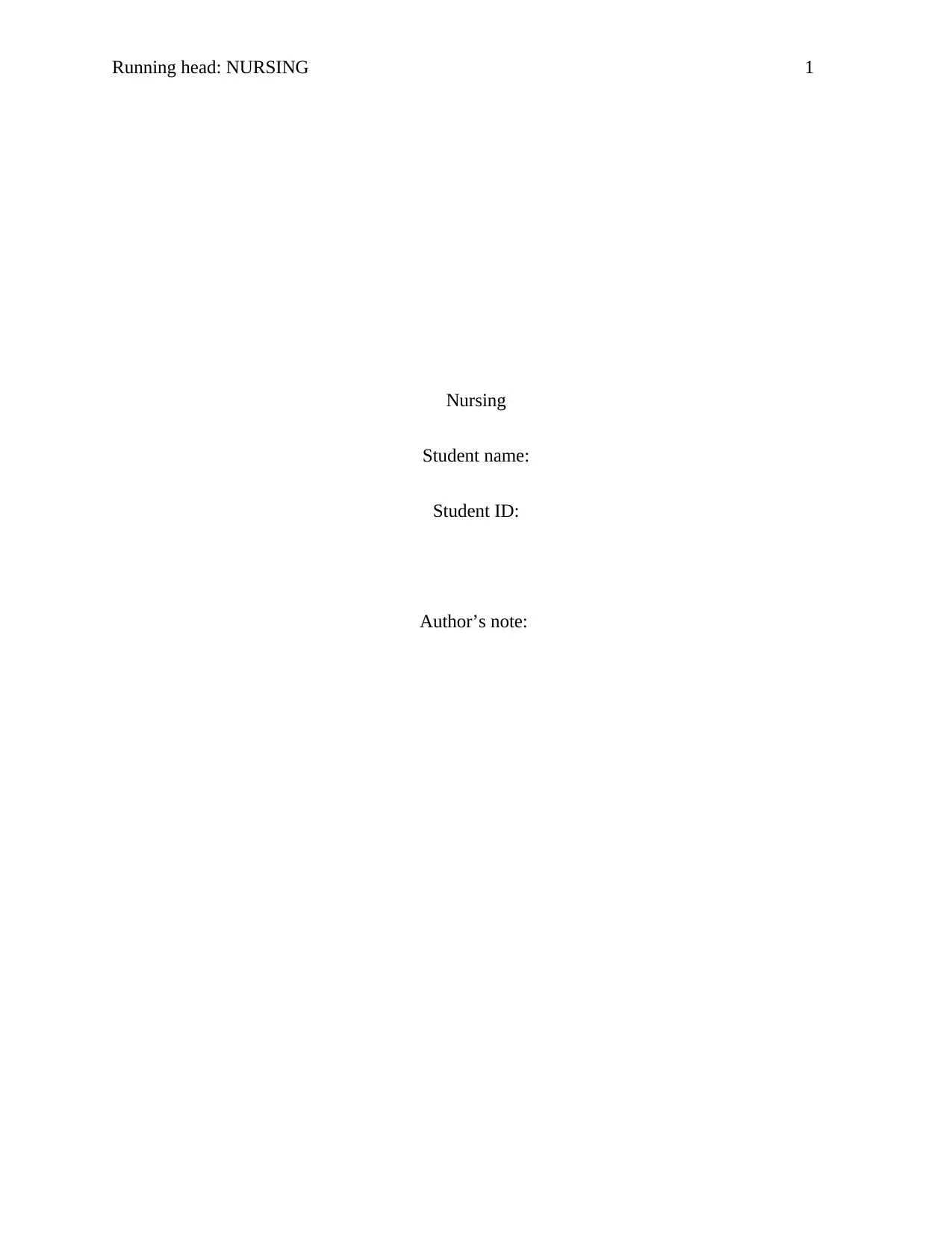
Running head: NURSING 1
Nursing
Student name:
Student ID:
Author’s note:
Nursing
Student name:
Student ID:
Author’s note:
Paraphrase This Document
Need a fresh take? Get an instant paraphrase of this document with our AI Paraphraser
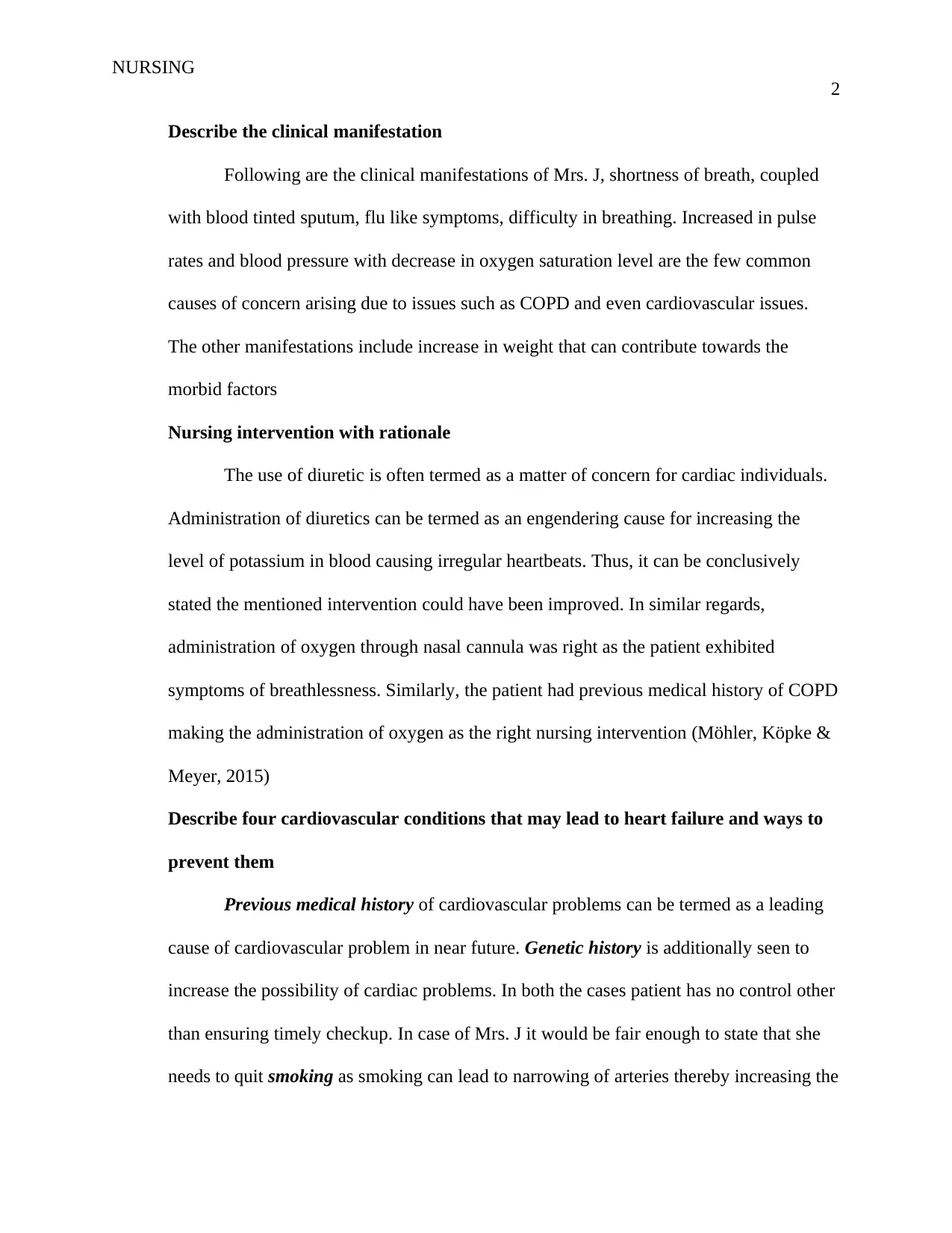
NURSING
2
Describe the clinical manifestation
Following are the clinical manifestations of Mrs. J, shortness of breath, coupled
with blood tinted sputum, flu like symptoms, difficulty in breathing. Increased in pulse
rates and blood pressure with decrease in oxygen saturation level are the few common
causes of concern arising due to issues such as COPD and even cardiovascular issues.
The other manifestations include increase in weight that can contribute towards the
morbid factors
Nursing intervention with rationale
The use of diuretic is often termed as a matter of concern for cardiac individuals.
Administration of diuretics can be termed as an engendering cause for increasing the
level of potassium in blood causing irregular heartbeats. Thus, it can be conclusively
stated the mentioned intervention could have been improved. In similar regards,
administration of oxygen through nasal cannula was right as the patient exhibited
symptoms of breathlessness. Similarly, the patient had previous medical history of COPD
making the administration of oxygen as the right nursing intervention (Möhler, Köpke &
Meyer, 2015)
Describe four cardiovascular conditions that may lead to heart failure and ways to
prevent them
Previous medical history of cardiovascular problems can be termed as a leading
cause of cardiovascular problem in near future. Genetic history is additionally seen to
increase the possibility of cardiac problems. In both the cases patient has no control other
than ensuring timely checkup. In case of Mrs. J it would be fair enough to state that she
needs to quit smoking as smoking can lead to narrowing of arteries thereby increasing the
2
Describe the clinical manifestation
Following are the clinical manifestations of Mrs. J, shortness of breath, coupled
with blood tinted sputum, flu like symptoms, difficulty in breathing. Increased in pulse
rates and blood pressure with decrease in oxygen saturation level are the few common
causes of concern arising due to issues such as COPD and even cardiovascular issues.
The other manifestations include increase in weight that can contribute towards the
morbid factors
Nursing intervention with rationale
The use of diuretic is often termed as a matter of concern for cardiac individuals.
Administration of diuretics can be termed as an engendering cause for increasing the
level of potassium in blood causing irregular heartbeats. Thus, it can be conclusively
stated the mentioned intervention could have been improved. In similar regards,
administration of oxygen through nasal cannula was right as the patient exhibited
symptoms of breathlessness. Similarly, the patient had previous medical history of COPD
making the administration of oxygen as the right nursing intervention (Möhler, Köpke &
Meyer, 2015)
Describe four cardiovascular conditions that may lead to heart failure and ways to
prevent them
Previous medical history of cardiovascular problems can be termed as a leading
cause of cardiovascular problem in near future. Genetic history is additionally seen to
increase the possibility of cardiac problems. In both the cases patient has no control other
than ensuring timely checkup. In case of Mrs. J it would be fair enough to state that she
needs to quit smoking as smoking can lead to narrowing of arteries thereby increasing the
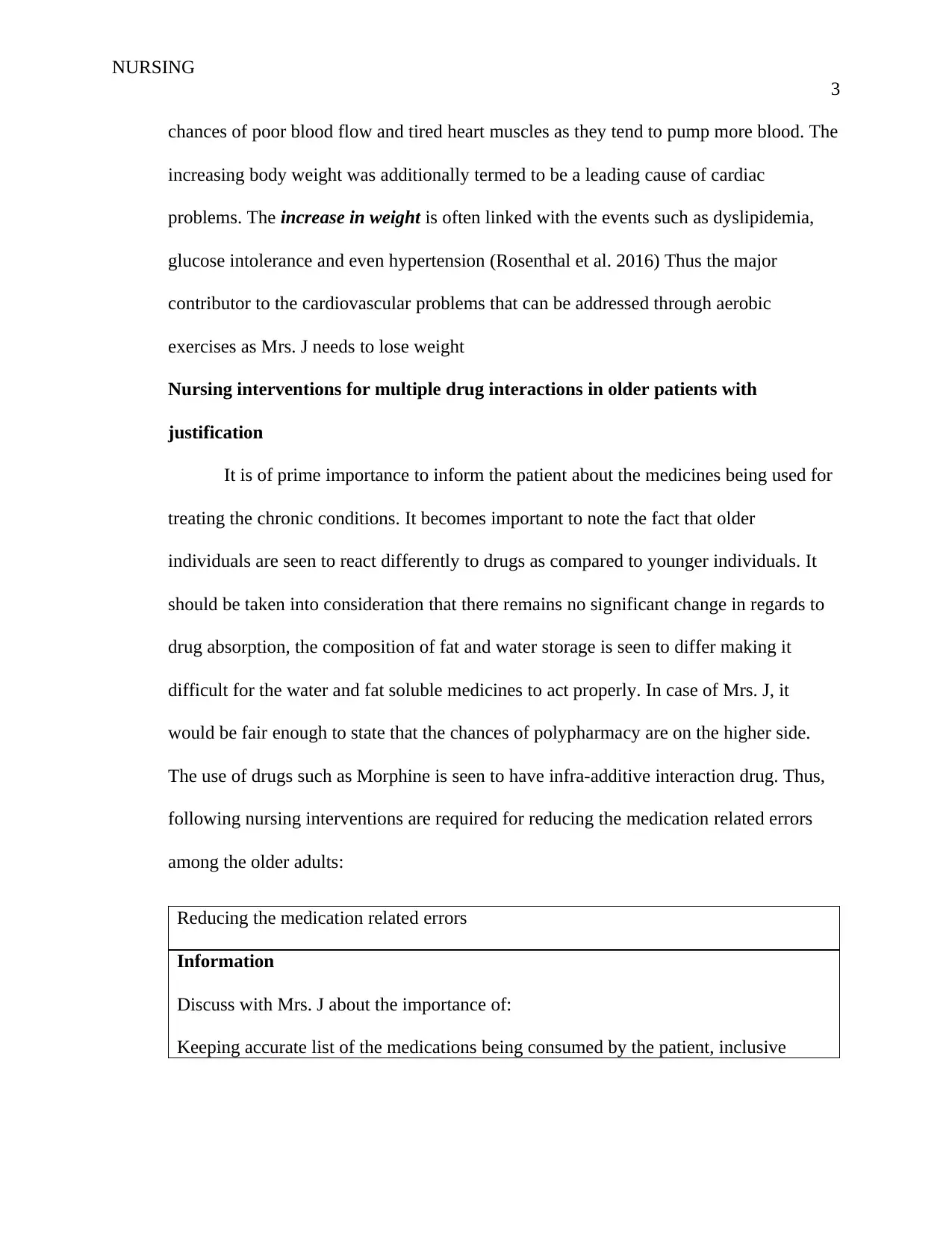
NURSING
3
chances of poor blood flow and tired heart muscles as they tend to pump more blood. The
increasing body weight was additionally termed to be a leading cause of cardiac
problems. The increase in weight is often linked with the events such as dyslipidemia,
glucose intolerance and even hypertension (Rosenthal et al. 2016) Thus the major
contributor to the cardiovascular problems that can be addressed through aerobic
exercises as Mrs. J needs to lose weight
Nursing interventions for multiple drug interactions in older patients with
justification
It is of prime importance to inform the patient about the medicines being used for
treating the chronic conditions. It becomes important to note the fact that older
individuals are seen to react differently to drugs as compared to younger individuals. It
should be taken into consideration that there remains no significant change in regards to
drug absorption, the composition of fat and water storage is seen to differ making it
difficult for the water and fat soluble medicines to act properly. In case of Mrs. J, it
would be fair enough to state that the chances of polypharmacy are on the higher side.
The use of drugs such as Morphine is seen to have infra-additive interaction drug. Thus,
following nursing interventions are required for reducing the medication related errors
among the older adults:
Reducing the medication related errors
Information
Discuss with Mrs. J about the importance of:
Keeping accurate list of the medications being consumed by the patient, inclusive
3
chances of poor blood flow and tired heart muscles as they tend to pump more blood. The
increasing body weight was additionally termed to be a leading cause of cardiac
problems. The increase in weight is often linked with the events such as dyslipidemia,
glucose intolerance and even hypertension (Rosenthal et al. 2016) Thus the major
contributor to the cardiovascular problems that can be addressed through aerobic
exercises as Mrs. J needs to lose weight
Nursing interventions for multiple drug interactions in older patients with
justification
It is of prime importance to inform the patient about the medicines being used for
treating the chronic conditions. It becomes important to note the fact that older
individuals are seen to react differently to drugs as compared to younger individuals. It
should be taken into consideration that there remains no significant change in regards to
drug absorption, the composition of fat and water storage is seen to differ making it
difficult for the water and fat soluble medicines to act properly. In case of Mrs. J, it
would be fair enough to state that the chances of polypharmacy are on the higher side.
The use of drugs such as Morphine is seen to have infra-additive interaction drug. Thus,
following nursing interventions are required for reducing the medication related errors
among the older adults:
Reducing the medication related errors
Information
Discuss with Mrs. J about the importance of:
Keeping accurate list of the medications being consumed by the patient, inclusive
⊘ This is a preview!⊘
Do you want full access?
Subscribe today to unlock all pages.

Trusted by 1+ million students worldwide
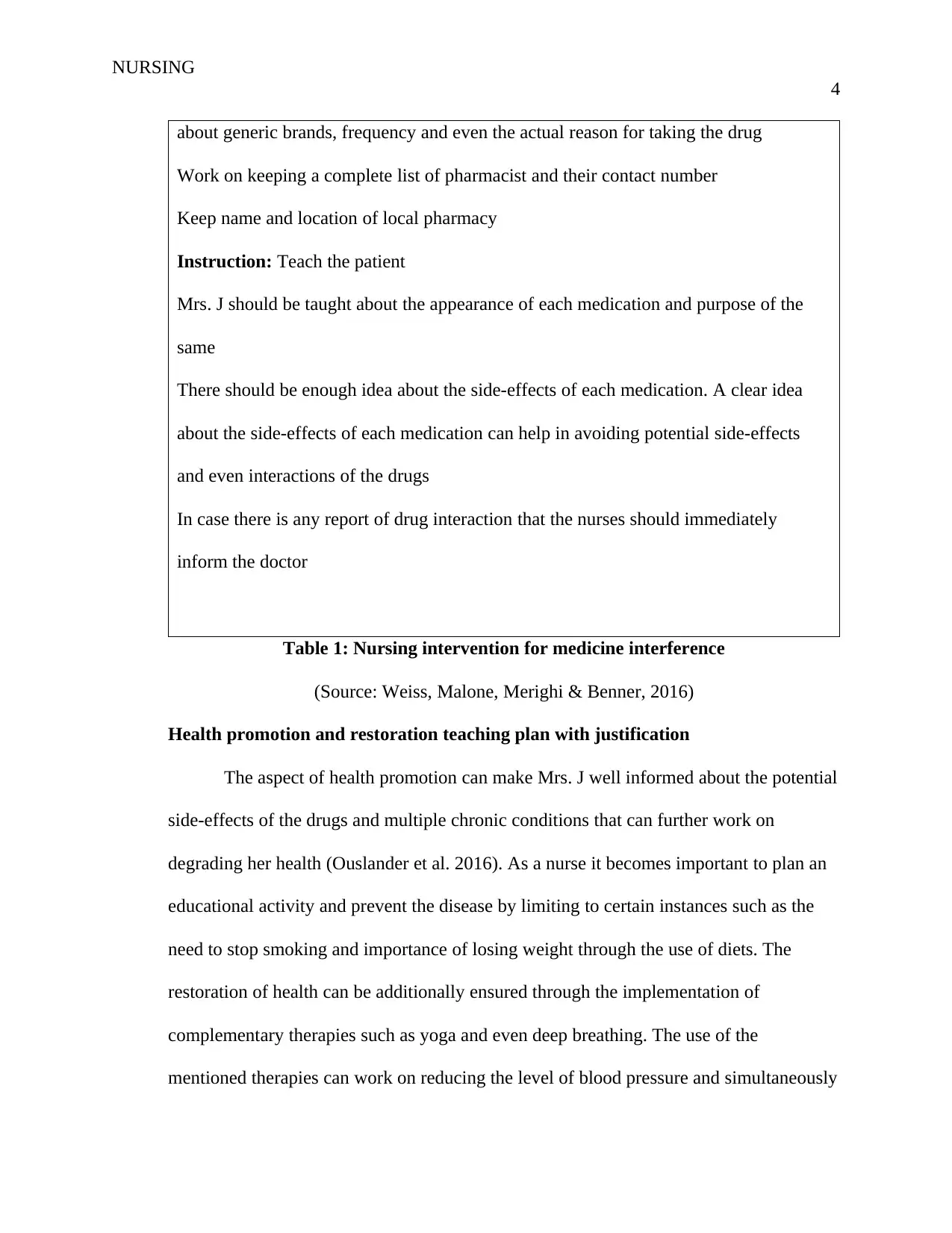
NURSING
4
about generic brands, frequency and even the actual reason for taking the drug
Work on keeping a complete list of pharmacist and their contact number
Keep name and location of local pharmacy
Instruction: Teach the patient
Mrs. J should be taught about the appearance of each medication and purpose of the
same
There should be enough idea about the side-effects of each medication. A clear idea
about the side-effects of each medication can help in avoiding potential side-effects
and even interactions of the drugs
In case there is any report of drug interaction that the nurses should immediately
inform the doctor
Table 1: Nursing intervention for medicine interference
(Source: Weiss, Malone, Merighi & Benner, 2016)
Health promotion and restoration teaching plan with justification
The aspect of health promotion can make Mrs. J well informed about the potential
side-effects of the drugs and multiple chronic conditions that can further work on
degrading her health (Ouslander et al. 2016). As a nurse it becomes important to plan an
educational activity and prevent the disease by limiting to certain instances such as the
need to stop smoking and importance of losing weight through the use of diets. The
restoration of health can be additionally ensured through the implementation of
complementary therapies such as yoga and even deep breathing. The use of the
mentioned therapies can work on reducing the level of blood pressure and simultaneously
4
about generic brands, frequency and even the actual reason for taking the drug
Work on keeping a complete list of pharmacist and their contact number
Keep name and location of local pharmacy
Instruction: Teach the patient
Mrs. J should be taught about the appearance of each medication and purpose of the
same
There should be enough idea about the side-effects of each medication. A clear idea
about the side-effects of each medication can help in avoiding potential side-effects
and even interactions of the drugs
In case there is any report of drug interaction that the nurses should immediately
inform the doctor
Table 1: Nursing intervention for medicine interference
(Source: Weiss, Malone, Merighi & Benner, 2016)
Health promotion and restoration teaching plan with justification
The aspect of health promotion can make Mrs. J well informed about the potential
side-effects of the drugs and multiple chronic conditions that can further work on
degrading her health (Ouslander et al. 2016). As a nurse it becomes important to plan an
educational activity and prevent the disease by limiting to certain instances such as the
need to stop smoking and importance of losing weight through the use of diets. The
restoration of health can be additionally ensured through the implementation of
complementary therapies such as yoga and even deep breathing. The use of the
mentioned therapies can work on reducing the level of blood pressure and simultaneously
Paraphrase This Document
Need a fresh take? Get an instant paraphrase of this document with our AI Paraphraser
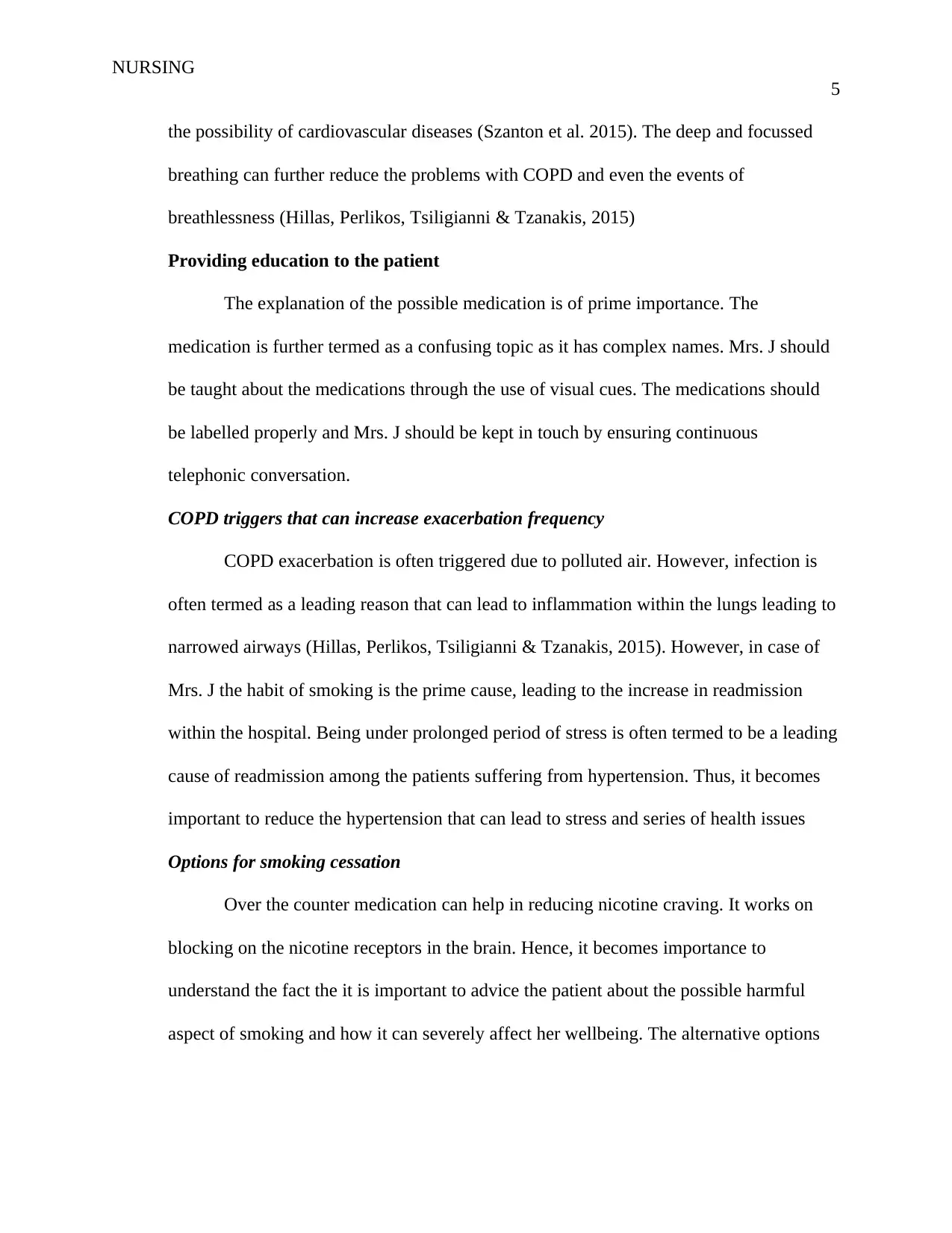
NURSING
5
the possibility of cardiovascular diseases (Szanton et al. 2015). The deep and focussed
breathing can further reduce the problems with COPD and even the events of
breathlessness (Hillas, Perlikos, Tsiligianni & Tzanakis, 2015)
Providing education to the patient
The explanation of the possible medication is of prime importance. The
medication is further termed as a confusing topic as it has complex names. Mrs. J should
be taught about the medications through the use of visual cues. The medications should
be labelled properly and Mrs. J should be kept in touch by ensuring continuous
telephonic conversation.
COPD triggers that can increase exacerbation frequency
COPD exacerbation is often triggered due to polluted air. However, infection is
often termed as a leading reason that can lead to inflammation within the lungs leading to
narrowed airways (Hillas, Perlikos, Tsiligianni & Tzanakis, 2015). However, in case of
Mrs. J the habit of smoking is the prime cause, leading to the increase in readmission
within the hospital. Being under prolonged period of stress is often termed to be a leading
cause of readmission among the patients suffering from hypertension. Thus, it becomes
important to reduce the hypertension that can lead to stress and series of health issues
Options for smoking cessation
Over the counter medication can help in reducing nicotine craving. It works on
blocking on the nicotine receptors in the brain. Hence, it becomes importance to
understand the fact the it is important to advice the patient about the possible harmful
aspect of smoking and how it can severely affect her wellbeing. The alternative options
5
the possibility of cardiovascular diseases (Szanton et al. 2015). The deep and focussed
breathing can further reduce the problems with COPD and even the events of
breathlessness (Hillas, Perlikos, Tsiligianni & Tzanakis, 2015)
Providing education to the patient
The explanation of the possible medication is of prime importance. The
medication is further termed as a confusing topic as it has complex names. Mrs. J should
be taught about the medications through the use of visual cues. The medications should
be labelled properly and Mrs. J should be kept in touch by ensuring continuous
telephonic conversation.
COPD triggers that can increase exacerbation frequency
COPD exacerbation is often triggered due to polluted air. However, infection is
often termed as a leading reason that can lead to inflammation within the lungs leading to
narrowed airways (Hillas, Perlikos, Tsiligianni & Tzanakis, 2015). However, in case of
Mrs. J the habit of smoking is the prime cause, leading to the increase in readmission
within the hospital. Being under prolonged period of stress is often termed to be a leading
cause of readmission among the patients suffering from hypertension. Thus, it becomes
important to reduce the hypertension that can lead to stress and series of health issues
Options for smoking cessation
Over the counter medication can help in reducing nicotine craving. It works on
blocking on the nicotine receptors in the brain. Hence, it becomes importance to
understand the fact the it is important to advice the patient about the possible harmful
aspect of smoking and how it can severely affect her wellbeing. The alternative options
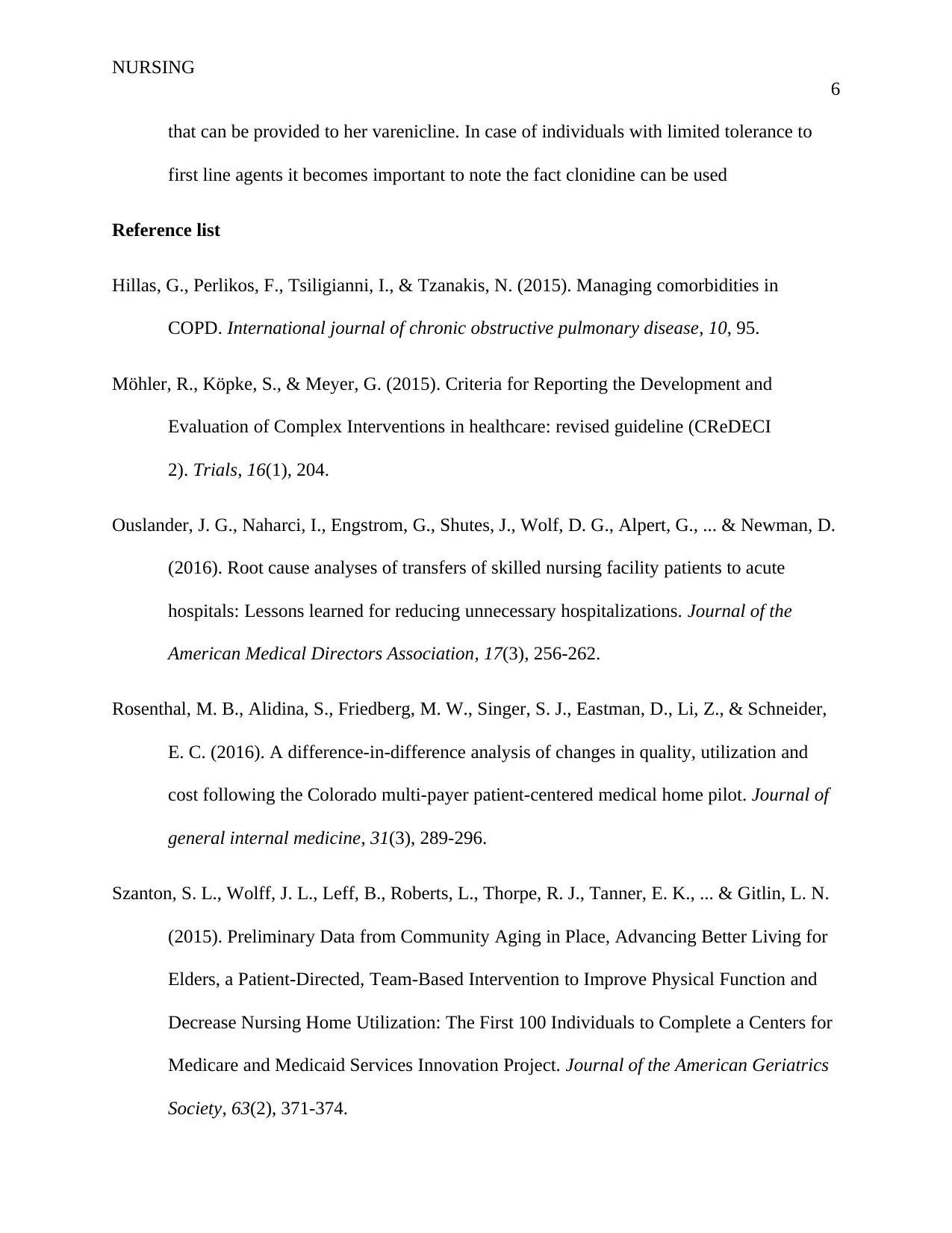
NURSING
6
that can be provided to her varenicline. In case of individuals with limited tolerance to
first line agents it becomes important to note the fact clonidine can be used
Reference list
Hillas, G., Perlikos, F., Tsiligianni, I., & Tzanakis, N. (2015). Managing comorbidities in
COPD. International journal of chronic obstructive pulmonary disease, 10, 95.
Möhler, R., Köpke, S., & Meyer, G. (2015). Criteria for Reporting the Development and
Evaluation of Complex Interventions in healthcare: revised guideline (CReDECI
2). Trials, 16(1), 204.
Ouslander, J. G., Naharci, I., Engstrom, G., Shutes, J., Wolf, D. G., Alpert, G., ... & Newman, D.
(2016). Root cause analyses of transfers of skilled nursing facility patients to acute
hospitals: Lessons learned for reducing unnecessary hospitalizations. Journal of the
American Medical Directors Association, 17(3), 256-262.
Rosenthal, M. B., Alidina, S., Friedberg, M. W., Singer, S. J., Eastman, D., Li, Z., & Schneider,
E. C. (2016). A difference-in-difference analysis of changes in quality, utilization and
cost following the Colorado multi-payer patient-centered medical home pilot. Journal of
general internal medicine, 31(3), 289-296.
Szanton, S. L., Wolff, J. L., Leff, B., Roberts, L., Thorpe, R. J., Tanner, E. K., ... & Gitlin, L. N.
(2015). Preliminary Data from Community Aging in Place, Advancing Better Living for
Elders, a Patient‐Directed, Team‐Based Intervention to Improve Physical Function and
Decrease Nursing Home Utilization: The First 100 Individuals to Complete a Centers for
Medicare and Medicaid Services Innovation Project. Journal of the American Geriatrics
Society, 63(2), 371-374.
6
that can be provided to her varenicline. In case of individuals with limited tolerance to
first line agents it becomes important to note the fact clonidine can be used
Reference list
Hillas, G., Perlikos, F., Tsiligianni, I., & Tzanakis, N. (2015). Managing comorbidities in
COPD. International journal of chronic obstructive pulmonary disease, 10, 95.
Möhler, R., Köpke, S., & Meyer, G. (2015). Criteria for Reporting the Development and
Evaluation of Complex Interventions in healthcare: revised guideline (CReDECI
2). Trials, 16(1), 204.
Ouslander, J. G., Naharci, I., Engstrom, G., Shutes, J., Wolf, D. G., Alpert, G., ... & Newman, D.
(2016). Root cause analyses of transfers of skilled nursing facility patients to acute
hospitals: Lessons learned for reducing unnecessary hospitalizations. Journal of the
American Medical Directors Association, 17(3), 256-262.
Rosenthal, M. B., Alidina, S., Friedberg, M. W., Singer, S. J., Eastman, D., Li, Z., & Schneider,
E. C. (2016). A difference-in-difference analysis of changes in quality, utilization and
cost following the Colorado multi-payer patient-centered medical home pilot. Journal of
general internal medicine, 31(3), 289-296.
Szanton, S. L., Wolff, J. L., Leff, B., Roberts, L., Thorpe, R. J., Tanner, E. K., ... & Gitlin, L. N.
(2015). Preliminary Data from Community Aging in Place, Advancing Better Living for
Elders, a Patient‐Directed, Team‐Based Intervention to Improve Physical Function and
Decrease Nursing Home Utilization: The First 100 Individuals to Complete a Centers for
Medicare and Medicaid Services Innovation Project. Journal of the American Geriatrics
Society, 63(2), 371-374.
⊘ This is a preview!⊘
Do you want full access?
Subscribe today to unlock all pages.

Trusted by 1+ million students worldwide
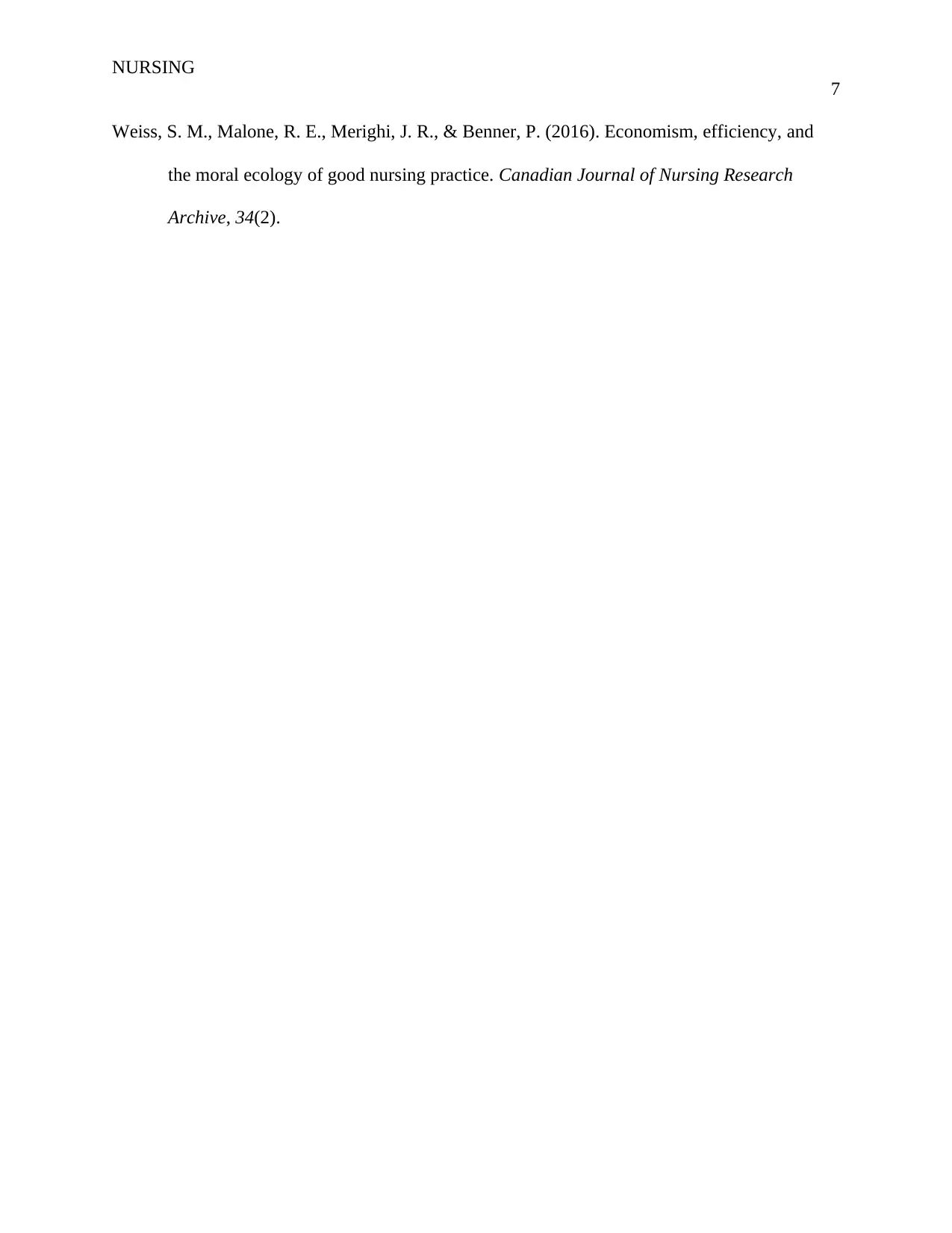
NURSING
7
Weiss, S. M., Malone, R. E., Merighi, J. R., & Benner, P. (2016). Economism, efficiency, and
the moral ecology of good nursing practice. Canadian Journal of Nursing Research
Archive, 34(2).
7
Weiss, S. M., Malone, R. E., Merighi, J. R., & Benner, P. (2016). Economism, efficiency, and
the moral ecology of good nursing practice. Canadian Journal of Nursing Research
Archive, 34(2).
1 out of 7
Related Documents
Your All-in-One AI-Powered Toolkit for Academic Success.
+13062052269
info@desklib.com
Available 24*7 on WhatsApp / Email
![[object Object]](/_next/static/media/star-bottom.7253800d.svg)
Unlock your academic potential
Copyright © 2020–2025 A2Z Services. All Rights Reserved. Developed and managed by ZUCOL.





